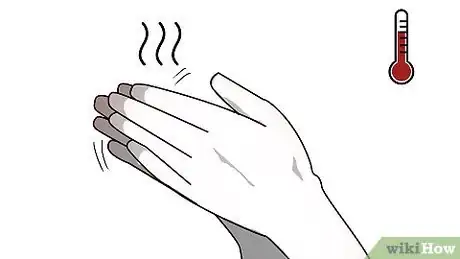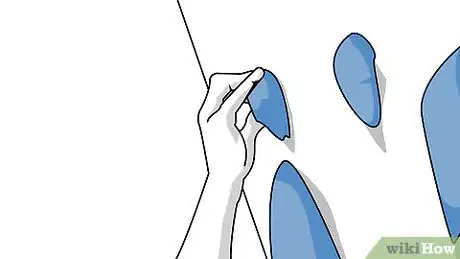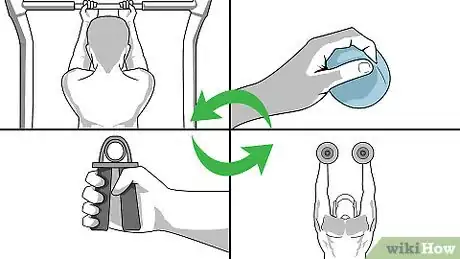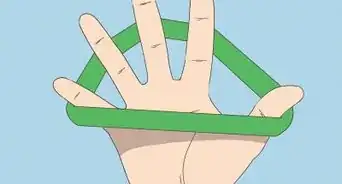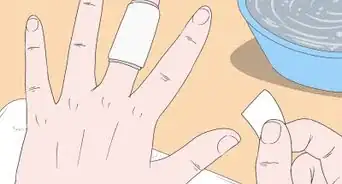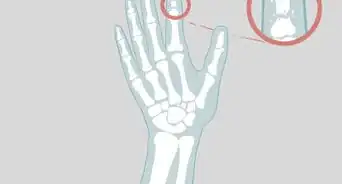This article was co-authored by Jourdan Evans, DPT. Jourdan Evans is an ACE (American Council on Exercise) certified Personal Trainer based in Los Angeles, California. She received her DPT in Physical Therapy from St. Ambrose University in 2012 and received her ACE certification in 2013.
wikiHow marks an article as reader-approved once it receives enough positive feedback. In this case, 100% of readers who voted found the article helpful, earning it our reader-approved status.
This article has been viewed 615,206 times.
Do you have weak fingers? Do you need to use them for something that requires flexibility? Do you want to have a better grip on jars and lids and slippery objects? How about holds for rock climbing or weightlifting? The right exercises can help improve the flexibility, suppleness, and strength of the joints to help people perform everything from basic activities of daily living to higher level physical activities.
Steps
Warming Up Your Fingers
-
1Warm up your fingers. Warming up is important part of any exercise routine. This includes your fingers.
-
2Massage the top and palm of your hand. Using the thumb, move in slow, circular strokes with medium-deep pressure for the massage. Do not put pressure to the point of pain.
- Massage for one to two minutes to help loosen and warm the muscles in the hands. This will get you the most out of your exercise routine.
Advertisement -
3Bend each finger. Bend each finger back until you feel a slight stretching. Then bend each finger forward. Do not perform to the point of pain.
-
4Soak hands in warm water. Soaking your hands for ten minutes or so before beginning exercises can warm them up and increase flexibility.
- Treating your hands with a warm paraffin wax bath can also be very helpful.
Performing Finger-Strengthening Exercises
-
1Hold your fist closed. Make a fist. Keep your thumb across your fingers and not tucked. Hold this pose for thirty seconds to a minute. Release it and spread the fingers out widely.[1] Begin with four reps of this if possible.
- If you cannot do four reps of any of these exercises at first, don’t worry. Do what you can without straining your muscles. You will find that you naturally build up to more reps with time.
- Be sure to consult with a physician or physical therapist before adding more than the recommended amount of reps to avoid the possibility of straining your hands.
-
2Flatten each hand against a flat surface. Place your hand palm-down on a table. Flatten the hand against the table’s surface as much as possible. Hold that pose for thirty second to a minute,[2] then release. Begin with four reps of this if possible.
-
3Squeeze a soft ball. For a grip-strengthening exercise, hold a soft ball in your palm and squeeze it hard for five seconds before releasing your grip. Work your way up to 10–15 repetitions, performed two to three times weekly. It is important to give yourself two days’ rest between grip-strengthening sessions.
- Do not perform this exercise if you have a thumb injury.
-
4Do “claw stretches.” In this exercise, called the “claw stretch,” hold your hands out in front of you, so you can visualize your palms. Then bend your fingers so that the tips rest against the base of your finger joints. Your hand will resemble a cat’s paw. Hold for thirty seconds to a minute before releasing.[3] Do four reps if possible.
-
5Touch your thumb to each of your fingers. One at a time, touch the pad of your thumb to the tip of each finger. Make sure that each touch makes an “O” shape. Do four reps of this exercise if possible.
- You can also do this exercise by touching your thumb to the pad of each finger. The shape made by your fingers will be more of an oval or egg shape.
-
6Do pinch strengtheners. To perform this exercise, pinch a bit of silly putty or a soft ball between the tips of your fingers and your thumb. Hold the pinch for thirty seconds to a minute. Build up to 10–15 repetitions if possible. You can perform two to three times each week with a two-day rest period between sessions.[4]
- Do not perform if you have a thumb injury.[5]
-
7Perform finger lifts. Place your hands flat on a table with your palms down. Lift up one finger at a time, then lower it. At the end, lift up all four fingers and the thumb then lower them. Do four reps of this if possible.
-
8Incorporate a rubber band. Wrap a rubber band around your hand at the base of the fingers. Extend the thumb and hold it before bringing it back in. If possible, work up to 10–15 reps. It is safe to do these exercises two to three times a week, but give your hands two days to rest between sets.[6]
-
9Do thumb-to-pinkie touches. Hold out your hand in front of you. Extend the thumb away from the hand as far as comfortable. Bend the thumb across the bottom of your hand to touch the base of your pinkie finger. Hold each pose for thirty seconds to a minute. Work up to four reps to begin with.[7]
-
10Do finger abduction and adduction exercises. This involves squeezing the fingers together and pulling the fingers apart from each other. Interlock your fingers and try to pull one hand away while the fingers of the other hand are squeezing towards each other trying to maintain the interlock.
- For strengthening the thumb to the pad of your fingers, you can put a piece of paper between thumb and pad, squeeze, and with opposite hand try to pull the paper from between your thumb and finger.
Exercising Fingers and Grip for More Strenuous Activities
-
1Utilize both isometric and dynamic strength-training activities. Climbers, bodybuilders, and others who use their hands and fingers for strenuous physical activity may also want to exercise fingers to increase strength. Two key components for exercising fingers include a balance of isometric and dynamic training activities.
- An isometric activity means holding a static position for an extended period of time.[8] A rock climber hanging by a particular grip while choosing his or her next move is an example of an isometric activity.
- A dynamic activity means moving a part of the body while supporting a load with the same part.[9] A push-up is a great example. You can see how you’re moving your arms during a push-up while supporting the load of your body on them as well.
- Going from a dead hang (isometric) into a pull-up (dynamic) is an example of an exercise that offers both. You can even tailor pull-ups to include exercising your fingers by keeping your grip on the bar closer to your fingertips than the palms of your hands.
- Make sure the when you are doing exercises where the hand/palm is holding the body up (push ups, planks, etc.), you are pressing through your knuckles and fingertips and not sinking into your wrists; this can cause wrist injury.
-
2Focus on tendons. Tendons are the sinew that connect muscles to bones and transmit force between them. Finger strength has more to do with the strength of the tendons that connect your finger bones to your forearm muscles than anything else.[10] Tendons take longer to strengthen and less time to degenerate, so you must stick to a disciplined workout regimen.
- For a general overview, you can find information at: How to Strengthen Tendons
-
3Exercise with a high focus on grip. One of the easiest ways to exercise fingers is to keep the emphasis on your grip rather than simply the forearm and bicep muscles. When you transition too much of the load onto your arm muscles, then your fingers don’t get as intense of a work out, even when your hands are involved in holding the weight.
-
4Use a hammer grip when lifting weights. A hammer grip is when you keep your palms facing one another during the range of motion while lifting a weight. Used most commonly with dumbbells, a hammer grip keeps the load on your fingers instead of resting it on the palms of your hands. This forces you to squeeze hard to keep your grip over several reps, which works both the finger tendons and associated forearm muscles.
-
5Increase the girth of your grip. Another way to keep the attention of your finger tendons and forearm muscles is to use a wider grip. A wider grip means you will have to squeeze harder to maintain your grip. You can purchase a specialty strength-training item such as Fat Gripz to go over a pull-up, dumbbell, or barbell to add more circumference, or you can simply wrap a household item such as a towel around the bar.
-
6Use handgrips. They may not be as glamorous as lifting large weights, but a plain old pair of handgrips with the metal tension coil between them can help you exercise your fingers as well. If you cannot find a pair, you can also squeeze a tennis ball, racquetball, or another household item with some give to it.
-
7Train progressively. Do not start by training to do chin-ups with only a few fingers on each hand or anything else beyond your training level. Tendon injuries require long periods of rehabilitation and often never return to pre-injury levels. The best thing you can do is train progressively.[11] Finger strength will develop slowly, so start easy and develop a more difficult routine over several months rather than weeks.[12]
Warnings
- People who have had injuries to their hands or thumbs or have brittle bones should consult with a doctor or physical therapist before beginning this or another exercise routine.⧼thumbs_response⧽
- Kaiser Permanente recommends that you consult with a doctor or physical therapist before beginning any at-home program. They can help choose the exercises that will work best for your individual needs.⧼thumbs_response⧽
- The National Institute on Aging notes that it is okay to challenge yourself to progress. If any of these exercises cause intense pain, this is a sign that you are overdoing it and can injure yourself. They recommend a slow and steady progression instead.[13]⧼thumbs_response⧽
- The National Institute on Aging also notes that progression will vary greatly from patient to patient. However, they note that once it is possible to do, for instance, 10-15 repetitions of an exercise easily and without pain, that it is okay to add another set to progress.[14]⧼thumbs_response⧽
References
- ↑ http://www.webmd.com/osteoarthritis/oa-treatment-options-12/slideshow-hand-finger-exercises
- ↑ http://www.webmd.com/osteoarthritis/oa-treatment-options-12/slideshow-hand-finger-exercises
- ↑ http://www.webmd.com/osteoarthritis/oa-treatment-options-12/slideshow-hand-finger-exercises
- ↑ http://www.webmd.com/osteoarthritis/oa-treatment-options-12/slideshow-hand-finger-exercises
- ↑ http://www.webmd.com/osteoarthritis/oa-treatment-options-12/slideshow-hand-finger-exercises
- ↑ http://www.webmd.com/osteoarthritis/oa-treatment-options-12/slideshow-hand-finger-exercises
- ↑ http://www.webmd.com/osteoarthritis/oa-treatment-options-12/slideshow-hand-finger-exercises
- ↑ http://www.rockclimbing.com/Articles/Training_and_Technique/Finger_Back_Arm_Strength_18.html
- ↑ http://www.rockclimbing.com/Articles/Training_and_Technique/Finger_Back_Arm_Strength_18.html
- ↑ http://www.rockclimbing.com/Articles/Training_and_Technique/Finger_Back_Arm_Strength_18.html
- ↑ http://www.rockclimbing.com/Articles/Training_and_Technique/Finger_Back_Arm_Strength_18.html
- ↑ http://www.rockclimbing.com/Articles/Training_and_Technique/Finger_Back_Arm_Strength_18.html
- ↑ https://order.nia.nih.gov/publication/get-fit-for-life-exercise-physical-activity-for-healthy-aging
- ↑ https://order.nia.nih.gov/publication/get-fit-for-life-exercise-physical-activity-for-healthy-aging
About This Article
To exercise your fingers, start by making a fist and holding it for 30 seconds. Then, spread out your fingers as wide as you can and repeat the exercise 4 times. Next, do 4 repetitions of flattening your hand palm-down on a table and pressing down on it for 30 seconds. You can also try squeezing a soft ball firmly in your palm for 5 seconds at a time, and repeating the motion 10 times. Additionally, touch each finger to the pad of your thumb so that it makes an “O” shape to stretch your finger muscles. For advice on how to build finger strength for activities like rock climbing or body building, read on!
